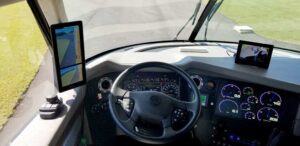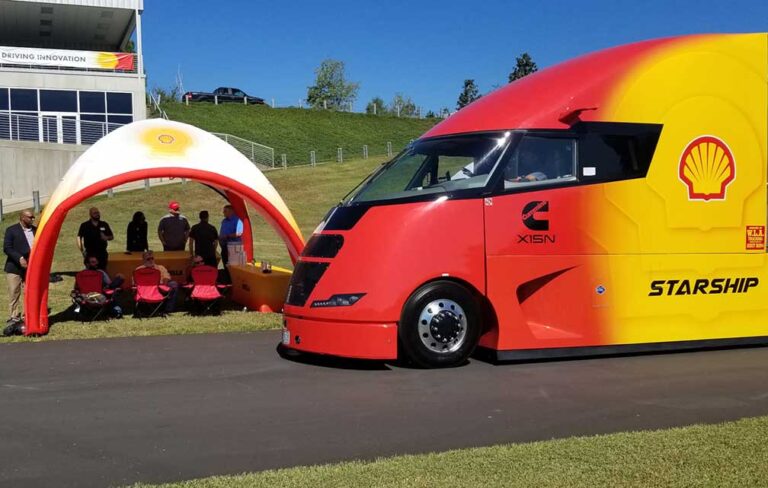The development of technology simply for the sake of using technology is not practical, nor is it useful.
That’s a lesson exemplified by the 48-cylinder, 4,200 CC Kawasaki Whitelock Tinker Toy, one of more than 1,000 motorcycles on display at the Barber Vintage Motorsports Museum in Leeds, Alabama. Although the bike holds the record for “functional vehicle with the greatest number of cylinders,” its fuel efficiency (or lack thereof) and required maintenance render it into nothing more than a novelty.
Enter the Shell Starship program.
At the other end of the practicality spectrum are technological developments that have the potential to bring greater efficiency to an entire industry.
On Oct. 8, 2024, the Shell Starship 3.0 was put through its paces at Alabama’s Barber Motorsports Park Proving Ground, with all of the latest practical technology available for Class 8 trucks on display.
Members of trucking media from across North America were treated to a presentation about the technology used in the creation and operation of the vehicle, along with the opportunity to inspect and photograph the latest iteration of the truck.
Some attendees received rides around the proving grounds track — while those with CDLs, including this writer, were encouraged to drive a lap or two. Of course, I took the opportunity to take the Starship for a spin.
The Shell Starship program began in 2018 with the goal of setting new benchmarks for energy efficiency for the commercial vehicle industry.
Combining the latest in aerodynamic design with lightweight and efficient drive train components, low rolling resistance tires and the most advanced Shell lubricants, each Starship iteration has set new standards for fuel efficiency and reduced emissions.
The Starship 3.0 deviates from the industry standard of diesel fuel, with a goal of meeting the Environmental Protection Agency’s (EPA) upcoming emissions standards and, at the same time, to improve fuel mileage and reduce costs.
The Starship is powered by a Cummins X15N natural gas engine and can use renewable natural gas where available. The engine is lubricated with Shell Rotella NG Plus SAE 5W-30 FA-4 synthetic oil, which the developers say is capable of handling the higher heat load produced by natural gas engines. Shell Spirax S6 GME 40 lubricant, specially formulated for high-torque transmissions, protects the auto-shift unit.
The truck and trailer are equipped with some familiar technology — with a few adaptations.
The tractor body is constructed of carbon fiber for strength and weight reduction. Tractor side fairings covered the drive wheels. Cab extender fairings, both side and top, are designed to deploy at 50 mph, closing the tractor – trailer gap. Trailer side skirts extended to within an inch of the road surface and completely covered the trailer tires. A “boat tail” device at the rear of the trailer extended all the way down.
Because less air can move underneath the tractor and trailer, heat extractors are molded into the body of the cab behind the steer tires to prevent buildup of engine heat.
A 5,000-watt solar panel array, mounted on the roof of the trailer, provides charging for batteries without taxing the truck’s generator or increasing fuel consumption.
During on-road testing in the fall of 2023 while operating at nearly 80,000 pounds, the Starship 3.0 achieved more than 2.5 times the freight-ton per gallon efficiency of the U.S. average for Class 8 diesel trucks. Additionally, because natural gas requires less emissions aftertreatment, the unit scored more than three times the freight-ton efficiency for carbon dioxide emissions of its diesel equivalent.
A second Starship 3.0, a hybrid diesel-electric, is being tested in China.

So, what’s it like to pilot the Starship?
Driving the Starship 3.0 was a unique experience in some ways — but rather ordinary in others. Entering the cab using the electric powered fold-down stairway was reminiscent of similar stairs on smaller business jets. Raising the stairs closes the door, which blends nearly seamlessly into the passenger side of the cab.
Familiarizing myself with the cab involved checking out the display panels that replace traditional west-coast mirrors.
Mounted near the windshield pillars, these displays provided a superior view of the area alongside the truck with less head movement required to check them. An additional “blind spot” camera and display clearly shows anything that’s near the right side of the tractor. An electronic control mounted near the left mirror display controls adjustment of the camera view for each separate camera. In addition, there’s a “night view” available that uses infra-red technology to provide a clear view alongside the truck even when visibility is compromised.
The gauges are incorporated into a driver interface to the right of the steering wheel. Although the displays are digital, they look very similar to traditional gauges with “needles” that moved accordingly.
Operating the auto-shift transmission is as simple as rotating a switch located on a stem on the steering column, about where automobile shifters have been located for decades. The action was much like turning on windshield wipers in an automobile.
The traditional yellow and red parking brake/protection valve buttons operate as normal.
Once I was acclimated, we were on our way.
The Starship’s acceleration is smooth and powerful, with the transmission smoothly shifting as the truck’s speed increases. The natural gas powerplant provides power similar to that of a diesel engine, but perhaps a little higher RPM is needed to provide torque at startup. Controlling the Starship feels much like any other truck with smooth, responsive steering and solid controlled braking.
In some ways, driving the truck is a whole new experience.
The most noticeable driving difference I noticed was visual: The aerodynamic shape of the windshield and the side-to-side dimensions of the tractor make the cab seem cavernous.
Without lines painted on the proving ground test track, it took a little extra effort to determine lane positioning. The difference, however, doesn’t seem to be anything a driver wouldn’t become accustomed to within a few miles of driving.
While the Starship 3.0 is definitely different in looks, as well as in some functions, the overall driving experience doesn’t feel that different from any modern Class 8 vehicle, at least to me.
The engine even sounds like a diesel! The familiar odor of diesel exhaust was missing while I walked around the idling truck, replaced by a less-noticeable aroma.
At a time when it’s difficult to predict how the truck of the future will be powered, the team behind the Shell Starship 3.0 is demonstrating what can be achieved with currently available technology. As the world pursues zero-emissions vehicles, every extra mile and every reduction in emissions brings the trucking industry closer to zero — in a good way.
Cliff Abbott is an experienced commercial vehicle driver and owner-operator who still holds a CDL in his home state of Alabama. In nearly 40 years in trucking, he’s been an instructor and trainer and has managed safety and recruiting operations for several carriers. Having never lost his love of the road, Cliff has written a book and hundreds of songs and has been writing for The Trucker for more than a decade.







